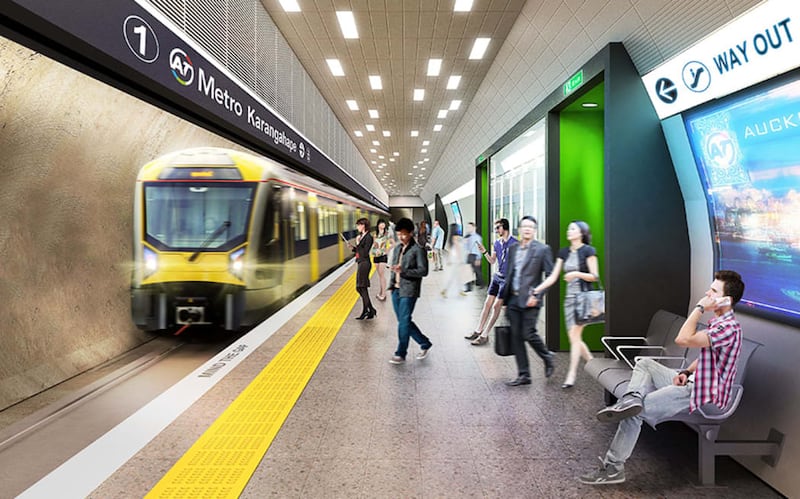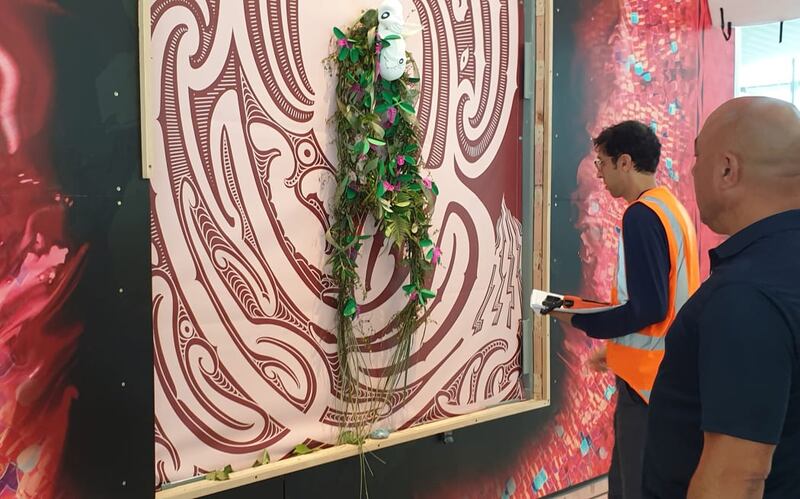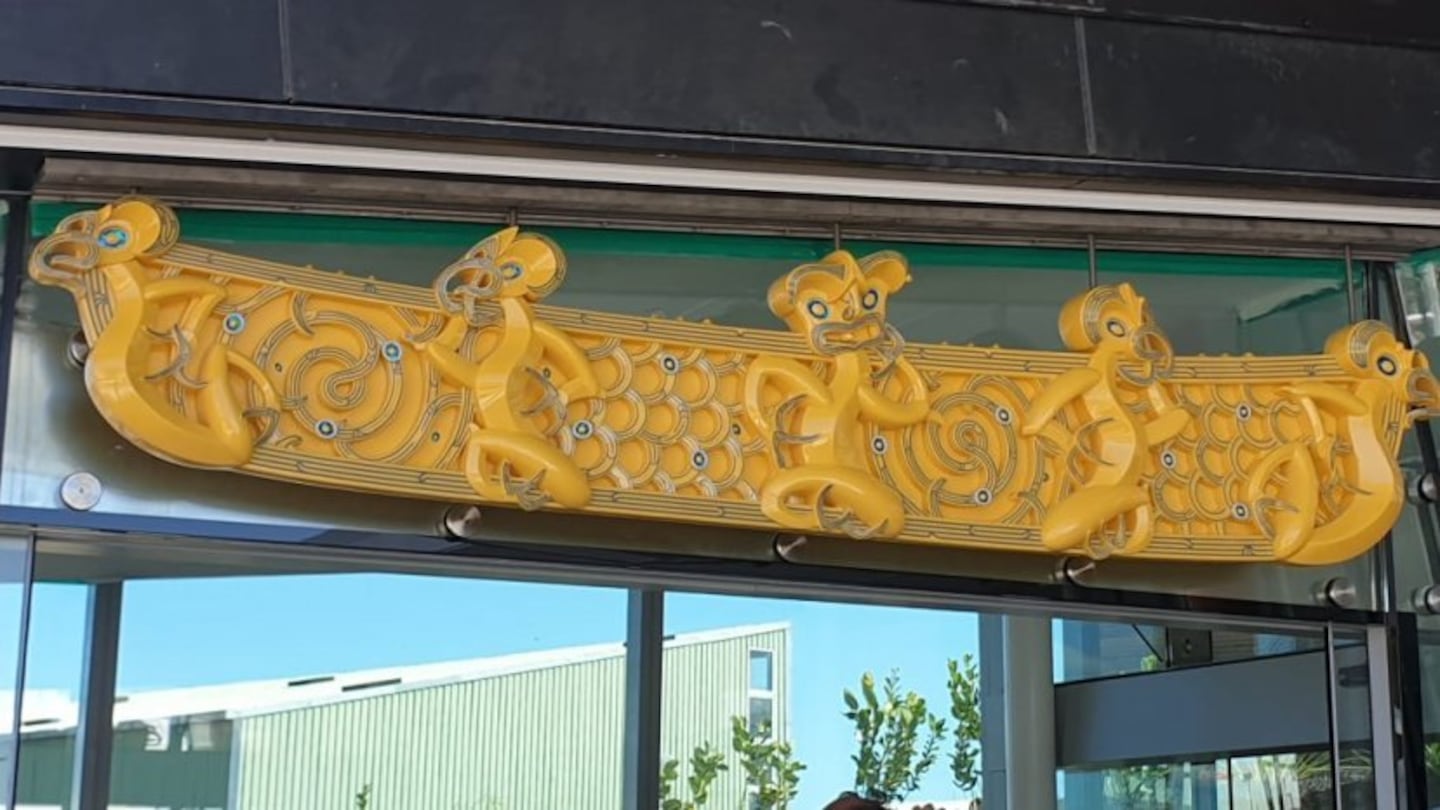A carving on New Plymouth's airport terminal. RNZ / Robin Martin
By Robin Martin, RNZ
A leading Māori architect says New Zealand towns and cities are suffering from a crisis of identity.
Rau Hoskins (Ngāti Hau, Ngāpuhi) is a director at Auckland-based designTRIBE architects and a lecturer at Unitec.
Speaking at the Govett Brewster Art Gallery and Len Lye Centre in New Plymouth this week, Hoskins said New Zealand towns and cities still had 90 percent of the original colonial architecture.
"That's the crisis really, we've got physical environments that don't talk back first of all to manawhenua, don't speak back to iwi from those places, and secondly don't talk to the true history of those areas."
Hoskins said New Zealand was only just starting to see the green shoots of architecture that begins to speak to the significance of those particular places and architecture which was being co-created with iwi and iwi artists, designers and representatives.
"Thankfully a process has begun to remedy that situation project by project so that everyone can appreciate a much better sense of place and some insights into the critical cultural narrative that apply to those particular locations."

A platform view of the proposed City Rail Link Karangahape Road station (artist's impression). Photo / Supplied
Hoskins outlined to an audience of about 100 people several projects around the country that had embraced indigenous design including the City Rail Link in Auckland.
"We began in 2012 putting together a group of iwi representatives from about eight different iwi in Tāmaki and worked with them to develop the manawhenua cultural principles that underpin the development of those four train stations."
Buy-in from Auckland Transport and City Rail Link leadership left "the door open" for iwi to be involved to provide design leadership for the station entrances.
"The parts we engage with the entrances, the foyers are the places that perhaps have the most meaning for us as transport users but also to manawhenua."
Each station has an Atua design narrative.
"For the redesigned Britomart Station which has thankfully been renamed Waitematā, it is the Tangaroa narrative, we're dealing with reclaimed land and when we move up Albert Street to Aotea centre.
"We looked into that name and it actually wasn't named by manawhenua, so the original name for that particular area and the stream running down Queen Street was Te Waihorotiu so that name was adopted for there. And the Atua there that was really evoked was Rongomatāne because that was an area of Auckland where significant cultivations were developed in and around what's now called Aotea Square."

The Britomart station (seen here), once redesigned will be renamed Waitematā. Photo: Twitter / Auckland Transport
The Karanga-a-Hape station's Atua is Tāne Mahuta representing the move further inland and at Maungawhau - the former Mt Eden Station - it is Matāoho the deity associated with volcanic activity.
"So all these narratives were developed and agreed with iwi representatives and the names or renaming process was all part of that six or seven year process that took off in earnest in 2013."
It was never too early to bring iwi, manawhenua onboard with a development project, Hoskins said.
In terms of the CRL, each station environment offered the opportunity to respond from a design aesthetic and from a cultural artwork perspective to the cultural narrative provocations.
At Maungawhau there was a nearby puna or spring famous in the area and the original idea had been to make that accessible to iwi again, but the water quality meant it couldn't happen.
"So, because we couldn't ... use the water we've chosen to focus on a running water narrative and so when you enter into the station you are going to come across an artwork by Ngāi Tai artist Tessa Harris which is a stunning piece of work involving ōnewa or basalt stone and with some glass elements as well.
"I'm just looking forward to overseas visitors and locals alike being able to really appreciate better their own city, being able to get insights into the city that the current environment doesn't allude to."

Artwork in the New Plymouth Airport terminal. RNZ / Robin Martin
Hoskins also cited the New Plymouth Airport / Papa Rererangi i Puketapu as an example where manawhenua - Te Aitiawa hāpu Puketapu - had a central role in the design of the new terminal, Te Hono.
"Very much, very much, this [is] my first time through the new airport and, of course, having worked with Rangi Kipa on a number of projects in the past I absolutely rate the work that he does.
"It's a perfect example and the Gisborne Airport is another one, the Hawke's Bay Airport. We've actually got some excellent processes that have been adopted by the airport authorities working with local iwi and local iwi being able to get their best involved in embedding design narratives into those physical environments.
The New Plymouth Airport's terminal Te Hono has gone on to win national and international design awards.
"These projects are on the world stage and thankfully there's more and more coming through and while there's a lot of work to be done we can point to more and more good examples such as those."



